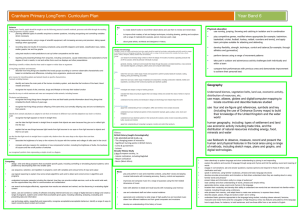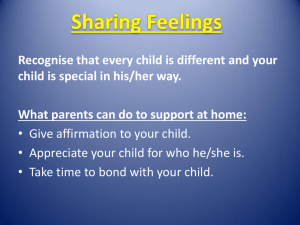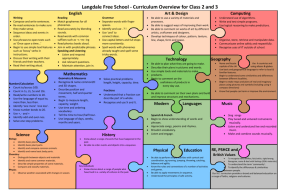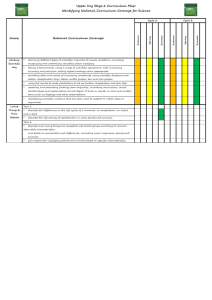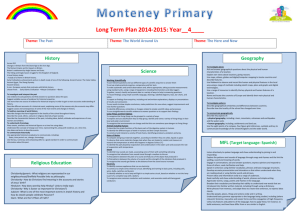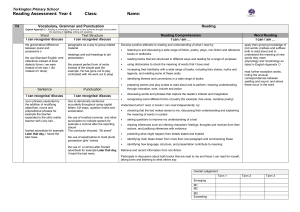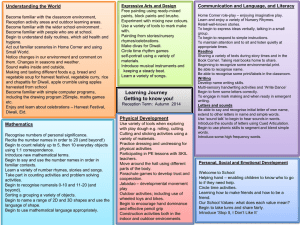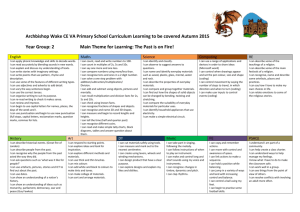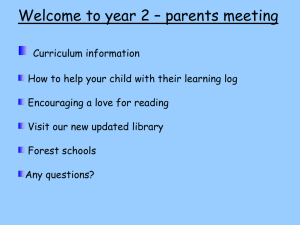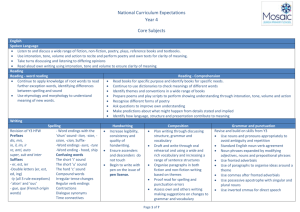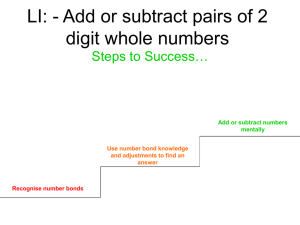Click here - St. Gregory`s Catholic Primary School
advertisement
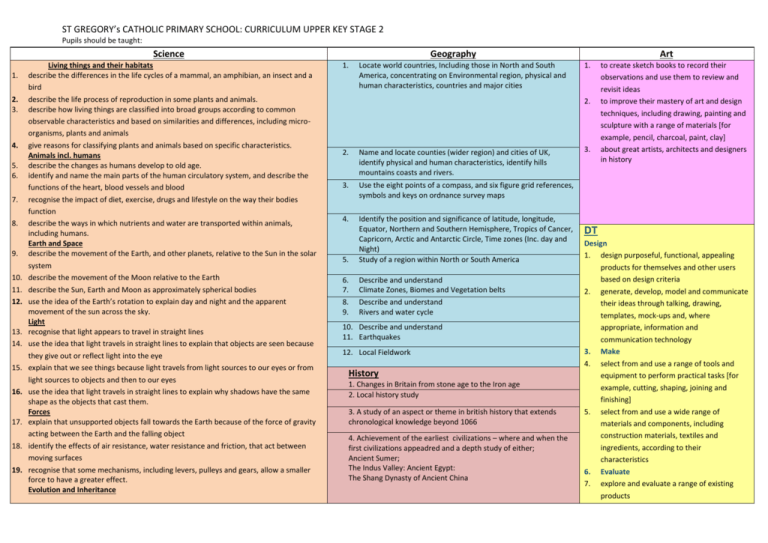
ST GREGORY’s CATHOLIC PRIMARY SCHOOL: CURRICULUM UPPER KEY STAGE 2 Pupils should be taught: Science 1. 2. 3. 4. 5. 6. 7. 8. 9. 10. 11. 12. 13. 14. 15. 16. 17. 18. 19. Living things and their habitats describe the differences in the life cycles of a mammal, an amphibian, an insect and a bird describe the life process of reproduction in some plants and animals. describe how living things are classified into broad groups according to common observable characteristics and based on similarities and differences, including microorganisms, plants and animals give reasons for classifying plants and animals based on specific characteristics. Animals incl. humans describe the changes as humans develop to old age. identify and name the main parts of the human circulatory system, and describe the functions of the heart, blood vessels and blood recognise the impact of diet, exercise, drugs and lifestyle on the way their bodies function describe the ways in which nutrients and water are transported within animals, including humans. Earth and Space describe the movement of the Earth, and other planets, relative to the Sun in the solar system describe the movement of the Moon relative to the Earth describe the Sun, Earth and Moon as approximately spherical bodies use the idea of the Earth’s rotation to explain day and night and the apparent movement of the sun across the sky. Light recognise that light appears to travel in straight lines use the idea that light travels in straight lines to explain that objects are seen because they give out or reflect light into the eye explain that we see things because light travels from light sources to our eyes or from light sources to objects and then to our eyes use the idea that light travels in straight lines to explain why shadows have the same shape as the objects that cast them. Forces explain that unsupported objects fall towards the Earth because of the force of gravity acting between the Earth and the falling object identify the effects of air resistance, water resistance and friction, that act between moving surfaces recognise that some mechanisms, including levers, pulleys and gears, allow a smaller force to have a greater effect. Evolution and Inheritance Geography 1. Locate world countries, Including those in North and South America, concentrating on Environmental region, physical and human characteristics, countries and major cities Art 1. 2. 2. Name and locate counties (wider region) and cities of UK, identify physical and human characteristics, identify hills mountains coasts and rivers. 3. Use the eight points of a compass, and six figure grid references, symbols and keys on ordnance survey maps 4. 5. Identify the position and significance of latitude, longitude, Equator, Northern and Southern Hemisphere, Tropics of Cancer, Capricorn, Arctic and Antarctic Circle, Time zones (Inc. day and Night) Study of a region within North or South America 6. 7. 8. 9. Describe and understand Climate Zones, Biomes and Vegetation belts Describe and understand Rivers and water cycle 10. Describe and understand 11. Earthquakes 12. Local Fieldwork History 1. Changes in Britain from stone age to the Iron age 2. Local history study 3. A study of an aspect or theme in british history that extends chronological knowledge beyond 1066 4. Achievement of the earliest civilizations – where and when the first civilizations appeadred and a depth study of either; Ancient Sumer; The Indus Valley: Ancient Egypt: The Shang Dynasty of Ancient China 3. to create sketch books to record their observations and use them to review and revisit ideas to improve their mastery of art and design techniques, including drawing, painting and sculpture with a range of materials [for example, pencil, charcoal, paint, clay] about great artists, architects and designers in history DT Design 1. design purposeful, functional, appealing products for themselves and other users based on design criteria 2. generate, develop, model and communicate their ideas through talking, drawing, templates, mock-ups and, where appropriate, information and communication technology 3. Make 4. select from and use a range of tools and equipment to perform practical tasks [for example, cutting, shaping, joining and finishing] 5. select from and use a wide range of materials and components, including construction materials, textiles and ingredients, according to their characteristics 6. Evaluate 7. explore and evaluate a range of existing products ST GREGORY’s CATHOLIC PRIMARY SCHOOL: CURRICULUM UPPER KEY STAGE 2 20. 21. 22. 23. 24. 25. 26. 27. 28. 29. 30. 31. Pupils should be taught: recognise that living things have changed over time and that fossils provide information about living things that inhabited the Earth millions of years ago recognise that living things produce offspring of the same kind, but normally offspring vary and are not identical to their parents identify how animals and plants are adapted to suit their environment in different ways and that adaptation may lead to evolution. States of Matter compare and group together everyday materials on the basis of their properties, including their hardness, solubility, transparency, conductivity (electrical and thermal), and response to magnets know that some materials will dissolve in liquid to form a solution, and describe how to recover a substance from a solution use knowledge of solids, liquids and gases to decide how mixtures might be separated, including through filtering, sieving and evaporating give reasons, based on evidence from comparative and fair tests, for the particular uses of everyday materials, including metals, wood and plastic demonstrate that dissolving, mixing and changes of state are reversible changes explain that some changes result in the formation of new materials, and that this kind of change is not usually reversible, including changes associated with burning and the action of acid on bicarbonate of soda. Electricity associate the brightness of a lamp or the volume of a buzzer with the number and voltage of cells used in the circuit compare and give reasons for variations in how components function, including the brightness of bulbs, the loudness of buzzers and the on/off position of switches use recognised symbols when representing a simple circuit in a diagram. 5. A non-European society that provides contrasts with British History. Either early Islamic civilization, including; Study of Baghdad c. 900; Mayan civilization c. AD900; Benin (West Africa) c. AD 900-1300 listen attentively to spoken language and show understanding by joining in and responding explore the patterns and sounds of language through songs and rhymes and link the spelling, sound and meaning of words 3. engage in conversations; ask and answer questions; express opinions and respond to those of others; seek clarification and help* 4. speak in sentences, using familiar vocabulary, phrases and basic language structures 5. develop accurate pronunciation and intonation so that others understand when they are reading aloud or using familiar words and phrases* 6. present ideas and information orally to a range of audiences* 7. read carefully and show understanding of words, phrases and simple writing 8. appreciate stories, songs, poems and rhymes in the language 9. broaden their vocabulary and develop their ability to understand new words that are introduced into familiar written material, including through using a dictionary 10. write phrases from memory, and adapt these to create new sentences, to express ideas clearly 11. describe people, places, things and actions orally* and in writing evaluate their ideas and products against design criteria 9. Technical knowledge 10. build structures, exploring how they can be made stronger, stiffer and more stable 11. explore and use mechanisms [for example, levers, sliders, wheels and axles], in their products. Computing 1. 2. 3. 4. 5. 6. 7. Languages 1. 2. 8. design, write and debug programs that accomplish specific goals, including controlling or simulating physical systems; solve problems by decomposing them into smaller parts use sequence, selection, and repetition in programs; work with variables and various forms of input and output use logical reasoning to explain how some simple algorithms work and to detect and correct errors in algorithms and programs understand computer networks including the internet; how they can provide multiple services, such as the world wide web; and the opportunities they offer for communication and collaboration use search technologies effectively, appreciate how results are selected and ranked, and be discerning in evaluating digital content select, use and combine a variety of software (including internet services) on a range of digital devices to design and create a range of programs, systems and content that accomplish given goals, including collecting, analysing, evaluating and presenting data and information use technology safely, respectfully and responsibly; recognise acceptable/unacceptable behaviour; identify a range of ways to report concerns about content and contact. Music 1. 2. 3. 4. 5. 6. play and perform in solo and ensemble contexts, using their voices and playing musical instruments with increasing accuracy, fluency, control and expression improvise and compose music for a range of purposes using the inter-related dimensions of music listen with attention to detail and recall sounds with increasing aural memory use and understand staff and other musical notations appreciate and understand a wide range of high-quality live and recorded music drawn from different traditions and from great composers and musicians develop an understanding of the history of music. PE/Games 1. 2. 3. 4. 5. 6. use running, jumping, throwing and catching in isolation and in combination play competitive games, modified where appropriate [for example, badminton, basketball, cricket, football, hockey, netball, rounders and tennis], and apply basic principles suitable for attacking and defending develop flexibility, strength, technique, control and balance [for example, through athletics and gymnastics] perform dances using a range of movement patterns take part in outdoor and adventurous activity challenges both individually and within a team compare their performances with previous ones and demonstrate improvement to achieve their personal best. R.E The programme of ‘The Way, the Truth & the Life’ is followed
